Calf bottles and tube feeders on test
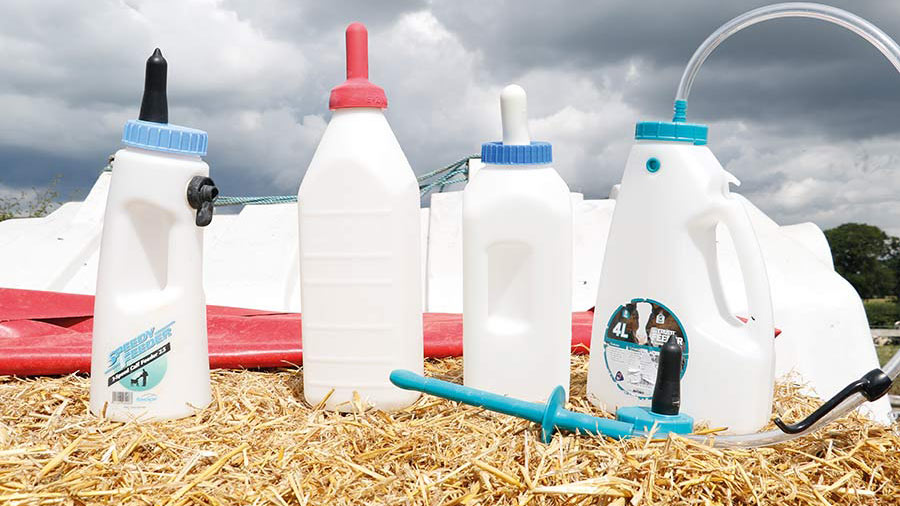 © MAG/Rhian Price
© MAG/Rhian Price It is unsurprising many farmers are switching from bottles to buckets with teats for feeding milk to older calves.
Our test, carried out over a four-month period at my family dairy farm in Shropshire where we feed dairy and beef calves twice a day, revealed a limited selection of decent bottles on the market.
Another disadvantage with bottles, when compared to buckets, is they are much harder to clean. But they are still a vital bit of kit for feeding newborn calves, whatever you decide to move on to.
Although the test we carried out is not an exhaustive list, it won’t be shocking to reveal we only tested three bottles, owing to the lack of choice in local stores, so we threw in a few tube feeders for comparison.
See also: Guide to feeding newborn calves colostrum
To reveal the merits of each feeder, we asked three calf feeders to try out each one over a four-month period. We then compiled their thoughts and gave each one a score.
The test was by no means scientific, and our views are subjective.
Here’s our verdict on how they compared.
- Superstart feeder (2.5 litres)
- Calf-feeding bottle with teat
- Shoof Speedy feeder (2.5 litres)
- Tube-feeding bags
- Trusti tube feeder starter kit
Superstart feeder (2.5 litres)
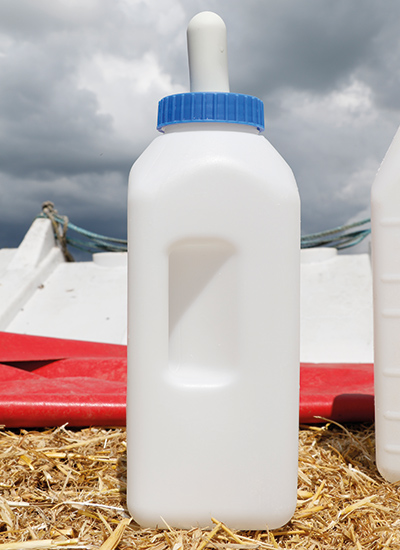
The Superstart feeder
© MAG/Rhian Price
Advantages:
- This bottle is a good size and can hold three litres of milk
- Handle makes it easy to feed calves
Disadvantages:
- Teats don’t last very long and need replacing every few weeks
- Graduation marks are not obvious
- Handle makes it more difficult to clean because not many brushes fit inside the handle and milk/colostrum can become congealed. We found the best way to clean them is to turn them upside down in a dedicated farm dishwasher.
Verdict: 3/5
Price: £11.26, available from Wynnstay. Teats cost £1.15 each (come in a pack of four costing £4.60) excluding VAT.
Calf-feeding bottle with teat
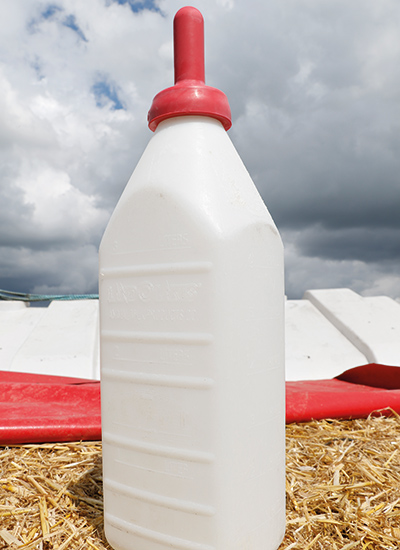
© MAG/Rhian Price
Advantages:
- Available in two sizes (2.65- and 3.8-litre capacities). We opted for the larger size
- Robust
- Easy to see graduation marks on the side when filling
- Designed to be used in conjunction with bottle holders, which makes them more expensive, but calves can be left to drink at their own speed which saves time
- Calves seem to latch on very quickly.
- Easy to clean with a brush because they don’t have a handle
Disadvantages:
- Snap-on teat can be a bit difficult to attach for the first few times until the rubber slackens
- Teats need replacing regularly as the holes become too large
- Bottle holders need cleaning, making an extra job to do.
Verdict: 4/5
Best for feeding older calves that are drinking well.
Cost: £11.34- £15.59 a bottle including VAT. Available to order online from Farm and Country Direct. Bottle holders are £19.80 each including VAT. Recommended using with square fencing. We cut holes in our fence and used cable ties to attach them, which was easy.
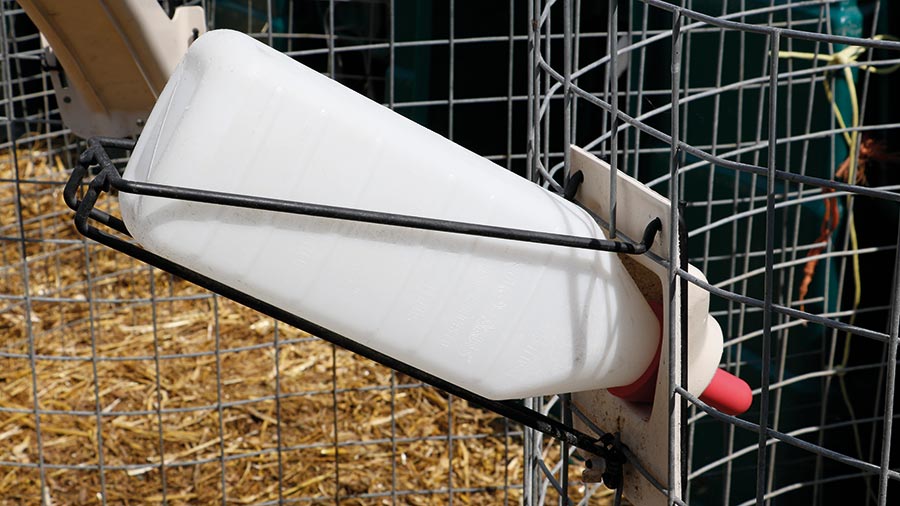
Bottle holder © MAG/Rhian Price
Shoof Speedy feeder (2.5-litre capacity)
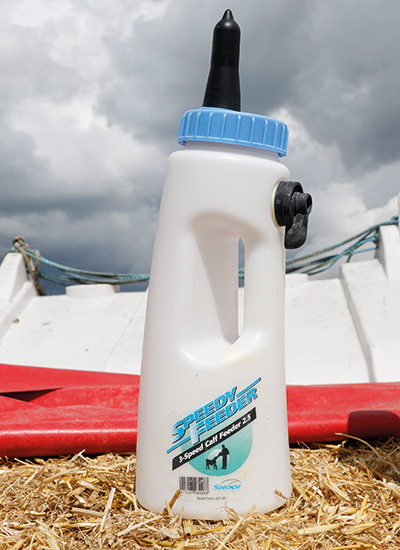
Shoof Speedy Feeding
© MAG/Rhian Price
Advantages:
- Lightweight
- Wider at the base than neck which aids drainage of milk
- Largest opening of the three bottles tested, which makes filling easy and avoids spilling milk
- Small and ergonomic peach teat design sees milk released from the sides of the teat. Calves seem to find it easier to suck from this in comparison with other, larger teats
- Three settings to control milk flow. Calves drank more quickly on maximum setting than from other bottles on maximum setting.
Disadvantages:
- Handle makes it harder to clean
- Thicker handle makes it more difficult to hold
- Doesn’t have a huge capacity and needs refilling halfway through feeding colostrum to ensure calves have enough. However, a 4-litre capacity is available and next time we would opt for this.
Verdict: 4.5/5
Most robust teat
Best for feeding newborn/small calves
Cost: £21 including VAT or £23.94 for the 4-litre feeder. Available from Kiwikit.
Tube-feeding bags
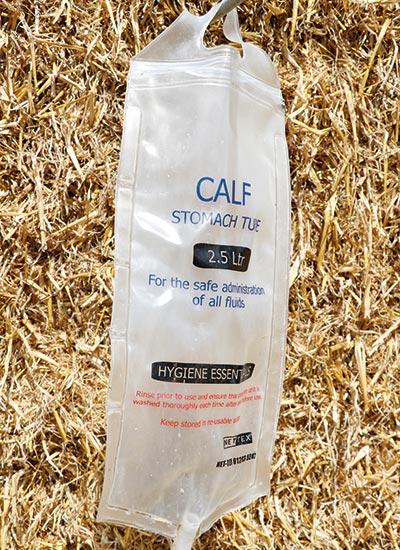
© MAG/Rhian Price
Advantages:
- Easy for one person to use
- Very quick to dispense the milk, although care needs to be taken the bag isn’t held too high and milk flow isn’t too fast
- Clear bag makes it easy to monitor progress.
Disadvantages:
- Handle breaks easily and bag splits down the side, creating spillages
- Calves can chew the tube over time, which makes the pipe abrasive and difficult to clean
- We tried using a metal pipe that could be attached to the bag, which was quite large in diameter and slightly uncomfortable for smaller calves, but much easier to clean and didn’t get damaged
- Bag is hard to clean – we soaked it overnight in disinfectant.
Verdict: 2.5/5
Cost: £15/bag. Purchased from Wynnstay, but available from a range of outlets.
Trusti tube feeder starter kit
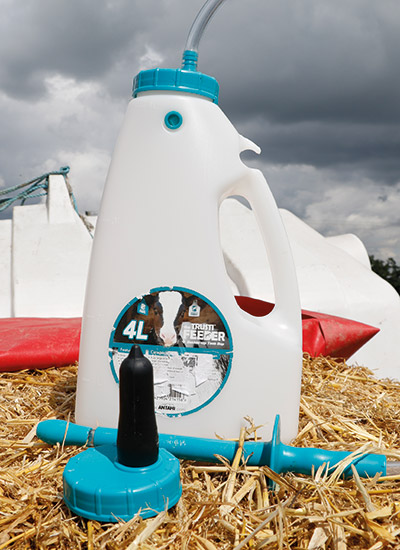
Trusti tube feeder © MAG/Rhian Price
Advantages:
- This is a unique bit of kit designed by New Zealand vet Ursula Haywood. It works by feeding a tube through the mouthpiece. There are markers on the side of the tube according to the size of the calf, which show you when to stop. This is meant to make it much easier to ensure the correct placement of the tube
- We tried it out with an inexperienced tube feeder, and she found it much easier to use in comparison to the bag because of this safety feature
- Because the bottle is closed, unlike the bag, it prevents bacteria getting into the milk/colostrum, as well as preventing spillages
- We purchased the 4-litre bottle, which is perfect for feeding colostrum as it doesn’t require refilling part-way through, unlike the bag, which only holds 2.5 litres.
- Easy to use with one hand
- Can be used on cattle up to 200kg.
Disadvantages:
- Much more expensive than bags, but lasts longer
Verdict: 4.5/5
Best for tube feeding
Cost: £69, purchased from Wynnstay but available from other outlets.
Is there one we haven’t tested but really should?
Send your suggestions to rhian.price@markallengroup.com and we’ll do our best to trial them and report our verdict in a future issue.
